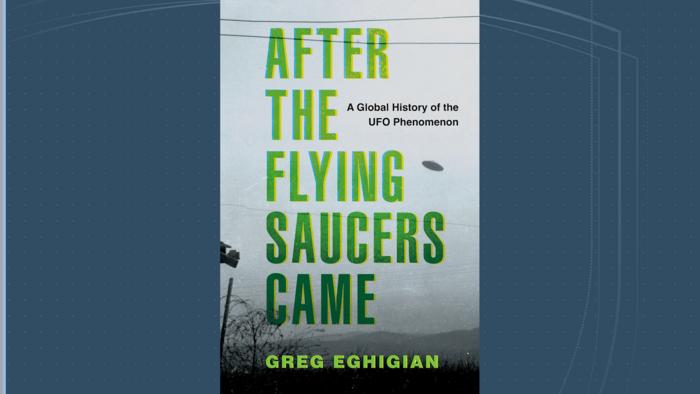UNIVERSITY PARK, Pa. — The end of the Second World War ushered in a new age, one dominated by novel technologies, the Cold War, the threat of nuclear destruction — and the first reported UFO sightings.

Credit: Oxford University Press
UNIVERSITY PARK, Pa. — The end of the Second World War ushered in a new age, one dominated by novel technologies, the Cold War, the threat of nuclear destruction — and the first reported UFO sightings.
Humans have witnessed strange aerial events since ancient times, but what makes UFOs unique is that the term “unidentified flying object” represents both a concept and a theory, according to Greg Eghigian, professor of history and bioethics at Penn State. In his new book, “After the Flying Saucers Came: A Global History of the UFO Phenomenon,” Eghigian explores how individuals, scientists, governments and the media responded to reports of UFO sightings and alien abductions and what those responses say about the human experience.
“Human beings have always tried to unpack mysterious phenomena,” Eghigian said. “Unpacking a phenomenon that still has no clear conclusion or any clear evidence means that we’re projecting values and ideas onto it. The story of UFOs is a story of the stories we tell ourselves about ourselves.”
In the book, Eghigian draws on archived material, old newspaper reports and expert interviews to trace the history of UFO sightings and alien encounters from around the globe. He also explores reactions to these reports, from hoaxers to military and scientific programs established to study the phenomenon to UFO supporters and skeptics. The history, Eghigian said, tells the story of where humans have been and where we as a species may go.
The UFO phenomenon partly draws on the science fiction and fantasy genres that began developing in the late 19th century, Eghigian explained. But UFO sightings really found their roots in the post-war world.
“UFOs are really a post-World War II phenomenon,” he said. “UFO sightings emerged out of the presence of a major war in which governments developed all sorts of new technologies like jet airplanes, rockets and the first intercontinental ballistic missiles, which introduced widescale bombings and new fears from the sky. The new technologies also introduced the possibility of going into outer space in a person’s lifetime. It’s a period where science fiction was becoming science fact.”
The looming presence of the Cold War, of nuclear destruction and of technologies built by secret government programs that nobody could even conceive of also played a part, he explained. In this climate, the idea that advanced, otherworldly technology was being piloted through the sky resonated with people.
The first sighting of what journalists later dubbed “flying saucers” occurred during a private flight on June 24, 1947, near Mount Rainer, Washington. Hundreds of reports of UFOs followed in succeeding weeks before media interest in the topic fizzled out in late August, Eghigian said. This first incidence established a trend of brief upticks in sightings and encounters reported by the media followed by waning interest that would play out from the late 1940s to the present day.
Radio and print media, especially pulp magazines, played a big part in publicizing the UFO phenomenon in the early years, Eghigian explained. He likened the reports to serial true crime podcasts today.
“Every new sighting or encounter introduces a new element to the plot,” he said. “What the media loves about UFOs is they’re a mystery — and a seemingly endless one at that. But the media doesn’t show consistent interest in the topic. That interest fluctuates over the years.”
“After the Flying Saucers Came” is meant not to debunk the UFO phenomenon but to tell the history and better understand what humans make of it, Eghigian said.
“The UFO phenomenon has always raised fundamental questions about our past, present and future,” Eghigian said. “Questions like, where do we come from? If there are aliens out there, did they have a hand in building this world?”
Many questions revolve around the existence of UFOs and aliens. If UFOs and aliens don’t exist, Eghigian said, can humans chalk up sightings to optical illusions, and what does that say about the brain? What are these objects, and who is behind them?
And the phenomenon’s focus on science and technology, he continued, serves as an image of what our future might hold.
“Can we achieve these scientific and technological advances?” Eghigian said. “Or are we going to destroy ourselves before we have a chance to do it?”
The stories of UFOs are, at heart, human stories. And that, to Eghigian, is as equally fascinating and mysterious as the UFOs themselves.



